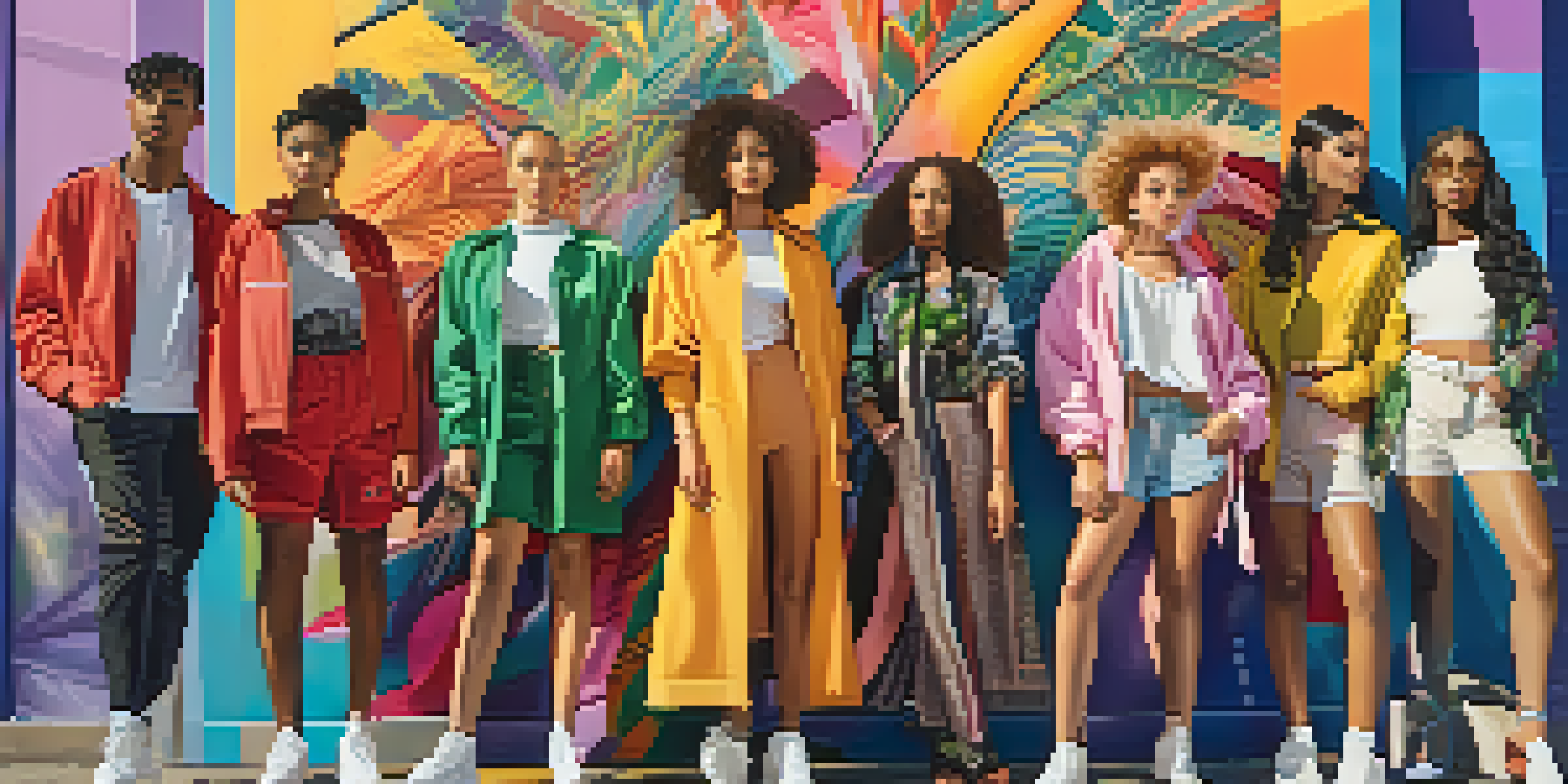Cultural Influences on Gender Representation in Fashion Ads

Understanding Gender Representation in Fashion Ads
Gender representation in fashion ads plays a crucial role in shaping societal norms. Advertisements often reflect and reinforce ideas about masculinity and femininity, influencing how individuals perceive themselves and others. The portrayal of gender can range from traditional roles to progressive representations, impacting consumer behavior and brand loyalty.
Advertising is a symbiotic relationship between the message and the audience. It reflects what we are and what we aspire to be.
For instance, a brand that showcases diverse body types and gender expressions may resonate with a broader audience, promoting inclusivity. This shift from stereotypical portrayals to more authentic representations allows audiences to see themselves within the brand's narrative. Such changes can foster a sense of belonging and challenge the status quo of gender expectations.
Ultimately, understanding gender representation in fashion ads is essential for brands aiming to connect with their audience meaningfully. As consumers become more conscientious about the messages conveyed through advertising, brands must adapt their strategies to reflect evolving cultural attitudes toward gender.
The Role of Culture in Shaping Gender Norms
Culture is a powerful force that shapes gender norms and expectations. Different societies have distinct beliefs and values that inform how gender roles are constructed and perceived. For example, in some cultures, traditional gender roles are rigid, while others embrace fluidity and diversity in gender expression.

Fashion ads often mirror these cultural nuances, adapting their portrayals of gender to align with societal expectations. Brands aiming to enter new markets must be particularly aware of local cultural norms to avoid misrepresentation or offense. A sensitive approach can enhance brand reputation and consumer trust.
Gender Ads Influence Society
Fashion advertisements shape societal norms by reflecting and reinforcing ideas about gender roles.
Understanding the cultural context in which fashion ads are produced is vital for creating effective campaigns. By respecting and reflecting local values, brands can foster deeper connections with their audience, ultimately leading to greater success in the market.
Historical Perspectives on Gender in Fashion Advertising
Historically, fashion advertising has played a significant role in perpetuating gender stereotypes. From the mid-20th century, ads often depicted women as homemakers and men as breadwinners, reinforcing traditional roles. This binary representation limited the scope of gender expression and marginalized those who did not fit within these confines.
Diversity is not a reason to celebrate; it’s a way of life. We should normalize the representation of all genders in our media.
As societal attitudes evolved, so too did the representations in fashion ads. The feminist movements of the 1960s and 70s challenged the status quo, leading to more diverse portrayals of women in advertisements. This shift marked the beginning of a broader conversation about gender representation and the need for authenticity in advertising.
Today, brands are increasingly aware of their historical legacy and the impact it has on their current messaging. By acknowledging past missteps, companies can work towards more inclusive and representative advertising strategies that resonate with today's consumers.
The Impact of Social Media on Gender Representation
Social media has revolutionized the way fashion ads are created and consumed, providing a platform for diverse voices and perspectives. Influencers and consumers alike can now challenge traditional gender representations and promote alternative narratives. This democratization of content creation encourages brands to listen and adapt to the changing landscape.
For instance, campaigns that emphasize body positivity and inclusivity often gain traction on platforms like Instagram and TikTok, where users celebrate individuality. This trend pushes brands to reconsider their portrayal of gender in advertising, leading to a more authentic reflection of society's diversity.
Cultural Sensitivity is Key
Brands must understand local cultural norms to create effective and respectful advertising campaigns.
Moreover, social media creates a feedback loop where consumers can directly influence brand narratives. Brands that embrace this interaction can foster loyalty and community, ultimately benefiting from a more engaged and diverse customer base.
Globalization and Its Effect on Gender Representation
Globalization has made the world more interconnected, allowing fashion brands to reach diverse audiences across the globe. However, this also presents challenges in terms of gender representation, as brands must navigate varying cultural norms and expectations. A campaign that resonates in one region may not be received the same way in another, highlighting the importance of cultural sensitivity.
As brands expand internationally, they often have to adapt their messaging to align with local gender norms. This may involve altering visuals, language, or even the products being promoted. Successful brands understand the need for a nuanced approach, taking care to honor cultural differences while promoting inclusivity.
Ultimately, globalization can lead to a richer tapestry of gender representation in fashion ads. By embracing and celebrating cultural diversity, brands can create more meaningful connections with their audiences, fostering a sense of global community.
Challenging Stereotypes Through Inclusive Advertising
Inclusive advertising goes beyond simply featuring diverse models; it challenges existing stereotypes and promotes a broader understanding of gender. Brands that take a stand against traditional gender norms can inspire change and encourage consumers to embrace their true selves. This approach not only resonates with audiences but also sets a precedent for the industry as a whole.
For example, campaigns that feature non-binary individuals or challenge conventional beauty standards can spark conversations about gender identity and expression. By showcasing real people with diverse experiences, brands can foster a sense of authenticity and relatability that resonates with their target audience.
Social Media Drives Change
The rise of social media empowers consumers to challenge traditional gender narratives and promotes inclusivity in advertising.
In this way, inclusive advertising becomes a powerful tool for social change. By challenging stereotypes and promoting diversity, brands can help shift societal perceptions of gender, creating a more accepting and inclusive world.
The Future of Gender Representation in Fashion Advertising
As societal attitudes toward gender continue to evolve, so too will fashion advertising. The future promises a more inclusive and representative approach, where brands prioritize authenticity and diversity. This shift is driven by consumers who demand more from the brands they support, pushing for a representation that reflects the complexities of modern identity.
Innovative technologies, such as augmented reality and virtual try-ons, may further transform how gender is represented in fashion ads. These advancements can allow for more personalized experiences, letting consumers see themselves in a variety of styles and identities. Brands that embrace these technologies while prioritizing diversity will likely lead the way in the industry.

Ultimately, the future of gender representation in fashion advertising lies in the hands of both brands and consumers. By working together to challenge stereotypes and promote inclusivity, we can create a more equitable landscape for all.